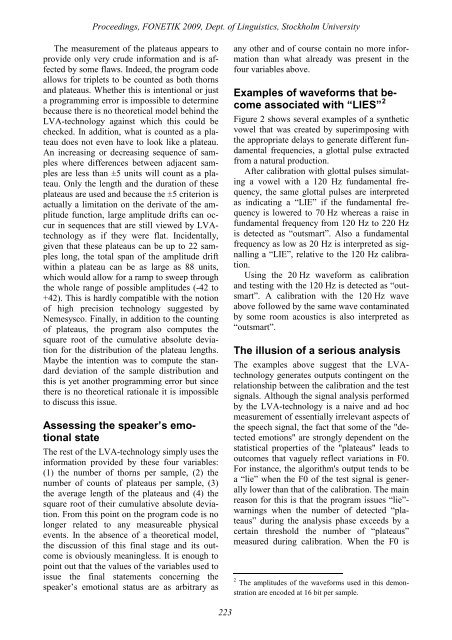Proceedings Fonetik 2009 - Institutionen för lingvistik
Proceedings Fonetik 2009 - Institutionen för lingvistik
Proceedings Fonetik 2009 - Institutionen för lingvistik
Create successful ePaper yourself
Turn your PDF publications into a flip-book with our unique Google optimized e-Paper software.
<strong>Proceedings</strong>, FONETIK <strong>2009</strong>, Dept. of Linguistics, Stockholm UniversityThe measurement of the plateaus appears toprovide only very crude information and is affectedby some flaws. Indeed, the program codeallows for triplets to be counted as both thornsand plateaus. Whether this is intentional or justa programming error is impossible to determinebecause there is no theoretical model behind theLVA-technology against which this could bechecked. In addition, what is counted as a plateaudoes not even have to look like a plateau.An increasing or decreasing sequence of sampleswhere differences between adjacent samplesare less than ±5 units will count as a plateau.Only the length and the duration of theseplateaus are used and because the ±5 criterion isactually a limitation on the derivate of the amplitudefunction, large amplitude drifts can occurin sequences that are still viewed by LVAtechnologyas if they were flat. Incidentally,given that these plateaus can be up to 22 sampleslong, the total span of the amplitude driftwithin a plateau can be as large as 88 units,which would allow for a ramp to sweep throughthe whole range of possible amplitudes (-42 to+42). This is hardly compatible with the notionof high precision technology suggested byNemesysco. Finally, in addition to the countingof plateaus, the program also computes thesquare root of the cumulative absolute deviationfor the distribution of the plateau lengths.Maybe the intention was to compute the standarddeviation of the sample distribution andthis is yet another programming error but sincethere is no theoretical rationale it is impossibleto discuss this issue.Assessing the speaker’s emotionalstateThe rest of the LVA-technology simply uses theinformation provided by these four variables:(1) the number of thorns per sample, (2) thenumber of counts of plateaus per sample, (3)the average length of the plateaus and (4) thesquare root of their cumulative absolute deviation.From this point on the program code is nolonger related to any measureable physicalevents. In the absence of a theoretical model,the discussion of this final stage and its outcomeis obviously meaningless. It is enough topoint out that the values of the variables used toissue the final statements concerning thespeaker’s emotional status are as arbitrary asany other and of course contain no more informationthan what already was present in thefour variables above.Examples of waveforms that becomeassociated with “LIES” 2Figure 2 shows several examples of a syntheticvowel that was created by superimposing withthe appropriate delays to generate different fundamentalfrequencies, a glottal pulse extractedfrom a natural production.After calibration with glottal pulses simulatinga vowel with a 120 Hz fundamental frequency,the same glottal pulses are interpretedas indicating a “LIE” if the fundamental frequencyis lowered to 70 Hz whereas a raise infundamental frequency from 120 Hz to 220 Hzis detected as “outsmart”. Also a fundamentalfrequency as low as 20 Hz is interpreted as signallinga “LIE”, relative to the 120 Hz calibration.Using the 20 Hz waveform as calibrationand testing with the 120 Hz is detected as “outsmart”.A calibration with the 120 Hz waveabove followed by the same wave contaminatedby some room acoustics is also interpreted as“outsmart”.The illusion of a serious analysisThe examples above suggest that the LVAtechnologygenerates outputs contingent on therelationship between the calibration and the testsignals. Although the signal analysis performedby the LVA-technology is a naive and ad hocmeasurement of essentially irrelevant aspects ofthe speech signal, the fact that some of the "detectedemotions" are strongly dependent on thestatistical properties of the "plateaus" leads tooutcomes that vaguely reflect variations in F0.For instance, the algorithm's output tends to bea “lie” when the F0 of the test signal is generallylower than that of the calibration. The mainreason for this is that the program issues “lie”-warnings when the number of detected “plateaus”during the analysis phase exceeds by acertain threshold the number of “plateaus”measured during calibration. When the F0 is2 The amplitudes of the waveforms used in this demonstrationare encoded at 16 bit per sample.223
















